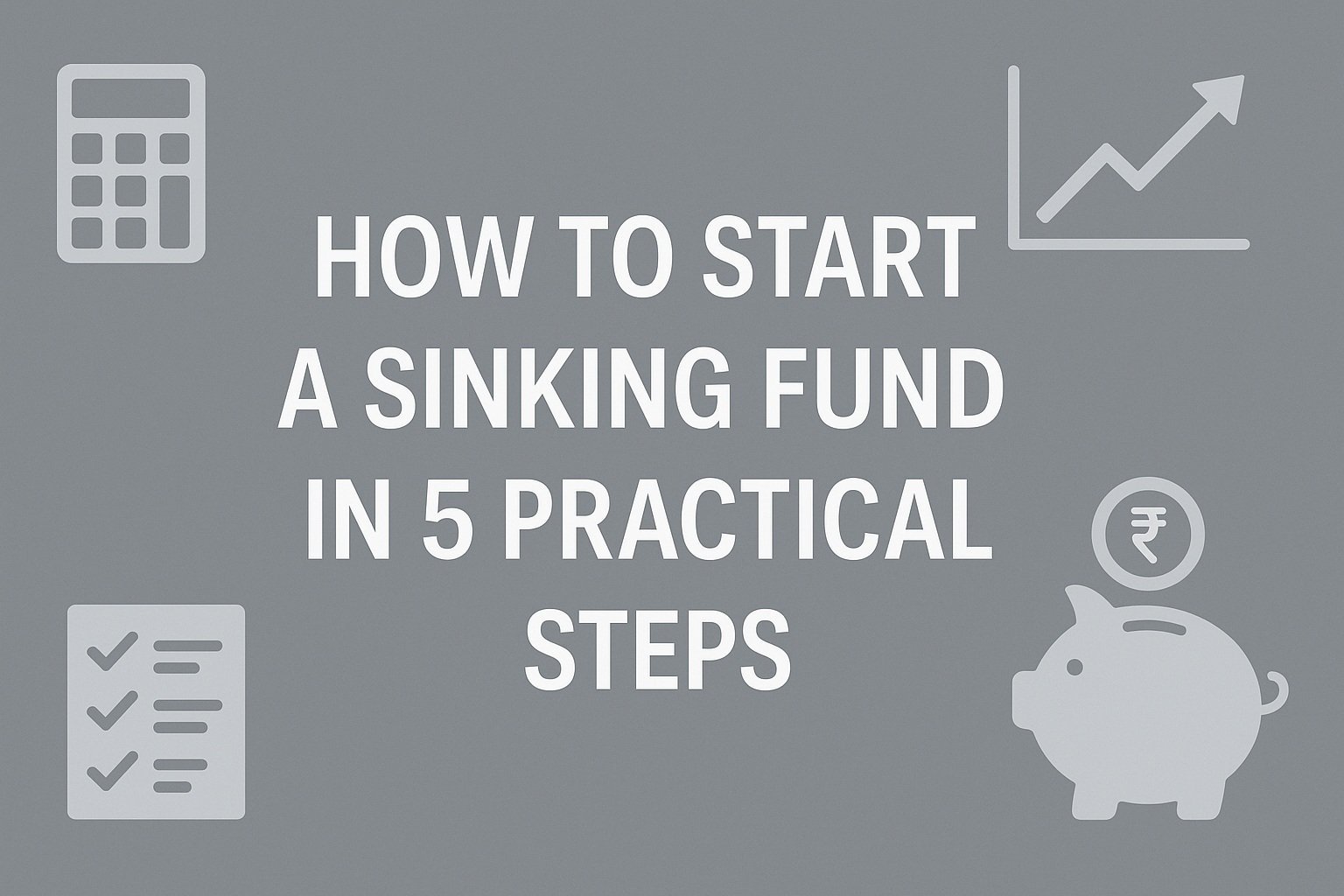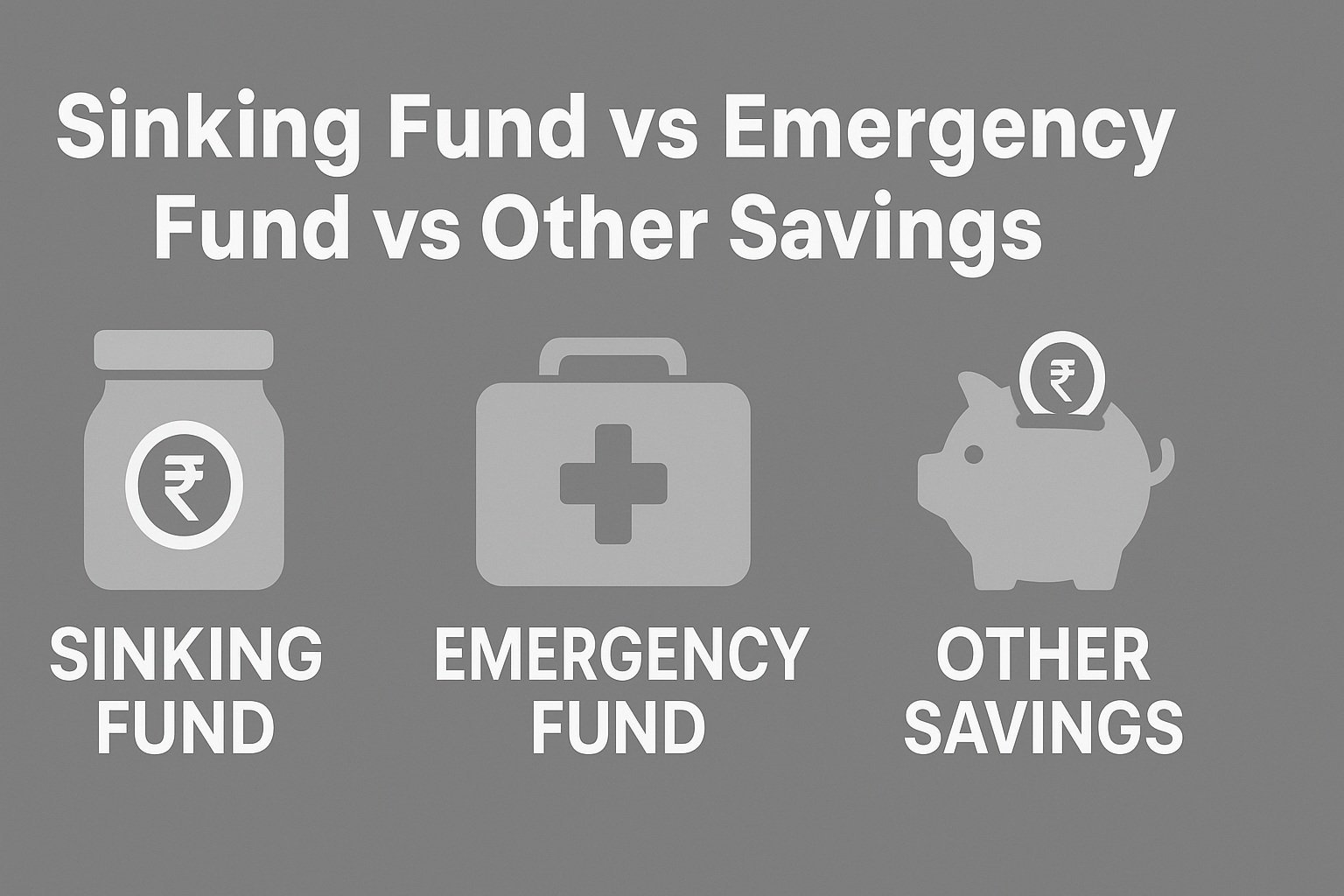Introduction
Imagine you’re dreaming of a new car, a summer vacation, or a home improvement project—but worrying about the sudden hit to your bank balance. That’s where sinking funds come in. A sinking fund is simply a dedicated pool of money you build over time for planned expenses. In this guide, you’ll discover what sinking funds are, see real-life examples, learn how to set one up step by step, compare them to emergency funds, explore a handy calculator, and pick up budgeting tips so you can tackle big purchases confidently.
What Exactly Is a Sinking Fund and Why Should You Care?
Imagine waking up to an unexpected car repair expense that wipes out your checking account or realising your property tax is due next month, and there is no cushion to cover it. We’ve all experienced the disheartening sensation when an unexpected, large-scale expense unexpectedly arises, causing your budget to spiral into chaos.
A sinking fund is simply a dedicated savings pool you build over time for specific, known future costs. By setting aside small amounts each month, you can prevent the last-minute scramble to find hundreds or thousands of rupees. Consider it a method of breaking down your financial objectives into manageable chunks that align with your income.
In this guide, you’ll get a simple, step-by-step system for funding everything from vehicle maintenance and home improvements to dream vacations—all without taking on debt or tapping into your emergency reserves. You’ll see real-world examples, learn how to calculate exactly what to save each month, and discover easy tools to keep your sinking funds on track.
Are you prepared to alleviate the burden of significant expenses? In the upcoming sections, we will guide you through practical examples and provide a useful calculator to help you start planning effectively right away.
Sinking Fund Basics (Definitions & Key Concepts)
2.1 What Is a Sinking Fund?
Back in the day, sinking funds were tools used by governments and corporations to repay bonds. They’d tuck away a little cash each period so when bondholders came calling, there was money ready to go. Fast forward to modern personal finance, and the idea is just as powerful for your household budget. Instead of relying on last-minute loans or credit cards, you set up a sinking fund—a dedicated pot where you deposit a fixed amount on a regular schedule for a known future expense.
It’s easy to mix up sinking funds with your emergency cushion, but they serve very different purposes. Consider annual insurance premiums, holiday gifts, or that new laptop you’ve been eyeing for your sinking fund. Conversely, an emergency fund serves as a safeguard against unforeseen circumstances such as sudden medical bills or an unexpected job loss. If you ever wonder about sinking funds vs emergency funds, just remember: one is for the bills you know are coming, and the other is for surprises you hope never arrive.
2.2 Why Sinking Funds Beat “Wing-It” Budgeting
When you fly by the seat of your pants each month, it can feel like financial whack-a-mole—one unexpected expense pops up and suddenly everything else takes a hit. Here’s why setting aside funds can transform your financial situation:
Psychological Benefits
-
Reduced anxiety: The knowledge that you’ve already allocated funds for a roof repair or annual vacation alleviates your burden.
-
Motivation boost: Watching each fund grow gives you a clear sense of progress and keeps you committed to your goals.
Financial Benefits
-
Avoid interest charges: Instead of financing a big purchase on credit at potentially high rates, you pay in cash you’ve already saved.
-
Timing flexibility: With your sinking fund, you control when to make the payment—no scrambling to borrow or juggling due dates.
| Wing-It Budgeting | Sinking Fund Approach |
|---|---|
| Surprise expenses derail plans | Planned contributions smooth cash flow |
| Risk of high-interest borrowing | Pay with cash, avoid finance charges |
| Stressful money juggling | Calm, predictable saving schedule |
By swapping last-minute scrambles for small, steady deposits, sinking funds turn financial stress into a simple, reliable process.
3. Choosing the Right Sinking-Fund Categories
When you’re setting up sinking funds, it helps to think through the full range of expenses you face each year. Below are sinking fund categories/examples to spark your list.

3.1 20+ Popular Categories (With Target Amounts)
-
Holiday gifts – ₹20,000 per year
-
Birthday presents – ₹12,000 per year
-
Annual insurance premiums – ₹15,000 per year
-
Car replacement – ₹200,000 over 5 years (₹40,000/year)
-
Vehicle maintenance – ₹6,000 every 6 months
-
Property tax – ₹24,000 per year
-
Home appliance upgrades – ₹30,000 over 2 years (₹15,000/year)
-
Roof repairs – ₹50,000 every 5 years (₹10,000/year)
-
Landscaping & gardening – ₹10,000 per year
-
Furniture refresh – ₹25,000 every 3 years (₹8,333/year)
-
Family vacation – ₹90,000 over 18 months (₹5,000/month)
-
Camera or electronics – ₹45,000 over 9 months (₹5,000/month)
-
Medical deductibles – ₹20,000 per year
-
Dental work – ₹12,000 per year
-
Pet care & vet visits – ₹6,000 per year
-
Pet emergency fund – ₹15,000 over 2 years (₹7,500/year)
-
Education or course fees – ₹50,000 per semester
-
Professional dues or memberships – ₹8,000 per year
-
Gadget accessories – ₹5,000 per year
-
Subscription renewals (software, clubs) – ₹6,000 per year
-
Charitable giving – ₹24,000 per year
-
Home emergency repairs (plumbing, electrical) – ₹12,000 per year
3.2 How to Prioritize When Money’s Tight
When cash is limited, utilise a needs versus wants matrix to determine which sinking funds should be prioritised for funding first:
| Needs (High Priority) | Wants (Lower Priority) |
|---|---|
| Property tax – mandatory and time-sensitive | Holiday gifts – nice but flexible timing |
| Annual insurance premiums – required to stay covered | Furniture refresh – can delay upgrade |
| Medical deductibles – protect health and finances | Gadget accessories – optional extras |
| Vehicle maintenance – avoids bigger breakdown costs | Subscription renewals – can trim unused services |
-
Fund all “Needs” first. These are non-negotiable and often carry penalties or higher costs if you miss them.
-
Consider adjusting or postponing “Wants” when cash flow is limited. Please allocate those contributions to the highest-priority sinking funds until your budget stabilises.
-
Revisit quarterly. As life evolves, please update your matrix and adjust contributions to ensure the essentials are always covered.
4. How to Start a Sinking Fund in 5 Practical Steps

4.1 Step 1: Set a SMART Savings Goal
Firstly, clearly define your savings objectives and the timeline for their completion. That means defining a Specific, Measurable, Achievable, Relevant, Time-bound goal. Please note the total cost and then select your deadline. Please divide the two, and you will have your monthly contribution.
Formula:
For example, if a new laptop costs ₹60,000 and you need it in 12 months, you’d save ₹5,000 each month (₹60,000 ÷ 12).
Want to see it in action? We invite you to use our sinking fund calculator to input your numbers and receive instant results.
4.2 Step 2: Pick the Right Account
We recognise that not all savings vehicles are equal. You’ll want an account that keeps your sinking-fund money separate and earning a bit of interest. Here’s a brief look:
| Account Type | Pros | Cons |
|---|---|---|
| High-yield savings | Competitive interest rates, FDIC insured | May have withdrawal limits |
| Bucket-style checking | Sub-accounts for each goal keep funds visible | Interest often lower than savings |
| Cash envelopes | Highly tangible, no fees | No interest, easy to overspend cash |
Choose the one that fits your style—whether that’s watching balances grow in an app or feeling the weight of cash envelopes in your wallet.
4.3 Step 3: Automate Contributions
The easiest way to make sure you actually save is to automate it. Consider arranging a payroll split to direct a portion of your pay cheque directly into your sinking fund. Many banks let you create automatic transfers on a schedule you choose. Or try a fintech app that rounds up purchases and deposits the spare change into your fund. Once it’s automatic, you can forget about it.
4.4 Step 4: Track Progress Visually
Seeing your fund grow is a powerful motivator. Use a simple spreadsheet template with columns for “Month”, “Contribution”, and “Balance”. If you prefer your phone, there are apps that let you snap screenshots of colourful progress bars. You could even print a tracker chart to pin on your fridge—every time you mark off a deposit, you’ll feel one step closer to your goal.
4.5 Step 5: Review & Rebalance Quarterly
Life—and prices—change. Every three months, revisit each sinking fund:
-
Has the cost estimate shifted?
-
Do you need to speed up or slow down contributions?
-
Are there new goals to add?
A quarterly check-in keeps your plan realistic and ensures you’ll hit every deadline without stress.
5. Advanced Strategies to Supercharge Your Sinking Funds
5.1 Earning Interest While You Save
Why let your sinking funds sit idle when they can work for you? Consider a laddered approach to Certificates of Deposit (CDs). Instead of locking all your money into a single long-term CD, split it into multiple CDs with staggered maturities—say, 3, 6, 9, and 12 months. As each CD matures, you can either spend the proceeds on your goal or roll it into a new 12-month CD at today’s higher rate.
Treasury bills are another safe, government-backed option. They typically offer better returns than basic savings accounts and mature in as little as four weeks or up to a year. Money-market funds combine the stability of short-term debt instruments with easy access—you can usually transfer money back to your checking account in one business day.
5.2 Using Cash-Back and Rewards to Boost Balances
If you already use a rewards credit card for everyday purchases, why not funnel those points or cash-back rewards directly into your sinking-fund buckets? For example, you could set your card to bill utilities, groceries, or gas—and when the statement arrives, transfer your earned cash back into your travel or home-repair fund. Some fintech apps let you automatically split rewards across multiple sinking funds, so you never miss a contribution.
Even store loyalty programmes can be helpful. If you have a card that gives you 5% back on groceries, roll those savings into your grocery sink fund. Over a year, small rewards can add up to thousands of rupees that accelerate your progress without touching your regular pay cheque.
5.3 Rolling Sinking Funds for Recurring Big Costs
Certain expenses, such as vehicle checkups, annual memberships, or seasonal tax bills, consistently occur. Rather than starting fresh each year, create a perpetual sinking fund that “rolls” forward. Here’s how it works: once you pay the expense, reset your timeline and continue contributing the same monthly amount.
For example, if your car maintenance cycle costs ₹12,000 annually, you’d save ₹1,000 each month. After you spend the ₹12,000, the fund balance drops to zero, but you keep the monthly transfer running. This ensures that you never miss a payment and always have the necessary funds available for the next service. This rolling method simplifies your sinking funds and guarantees that recurring costs never surprise you.
6. Common Mistakes & How to Avoid Them
6.1 Under-Funding by Guessing Totals
It’s tempting to ballpark an expense—“My vacation will cost around ₹50,000”—and then divide by your timeline. But if you underestimate, you’ll scramble to make up the shortfall at the end. Instead, take a few extra minutes to research or get quotes. Even a rough online check for hotel rates, insurance premiums, or repair costs can save you from a nasty surprise. If your estimate changes, please adjust your monthly contribution promptly to ensure the fund meets its target by the deadline.
6.2 Raiding Funds for Unrelated Spending
Your sinking funds should feel untouchable—like money you never planned to spend today. If you dip into one pot for an impulse purchase or an unexpected expense, you disrupt the disciplined cycle. To avoid temptation, label each account clearly (for example, “Car Maintenance Fund”) and consider using separate bank accounts or branded envelopes. In the event of an emergency requiring you to borrow from one, please consider it a mini loan and aim to replenish the full amount promptly.
6.3 Keeping Too Many Micro-Funds (Analysis Paralysis)
Creating a sinking fund for every conceivable cost—gum, stationery, pet treats—can lead to dozens of tiny accounts that are more work than benefit. When you spread your budget across too many micro-funds, it’s difficult to track progress and easy to lose interest. Instead, consolidate related goals. For example, combine “gadget accessories”, “phone case”, and “earbuds” into a single “Electronics Upgrades” fund. You’ll save time on tracking, reduce stress, and still hit all your objectives without drowning in spreadsheets.
7. Sinking Fund vs Emergency Fund vs Other Savings: Quick Comparison Table

When you’re building your savings strategy, it helps to see how sinking funds stack up against emergency funds and other common savings types. Refer to this quick comparison:
| Feature | Sinking Fund | Emergency Fund | Other Savings (e.g., Vacation Fund, Investment) |
|---|---|---|---|
| Purpose | Planned, known expenses | Unplanned, unexpected costs | Variable goals—from fun to wealth building |
| Timeline | Defined deadline (e.g., 6–24 months) | Indefinite (often held until needed) | Flexible, based on goal |
| Typical Size | Exact cost of anticipated expense | 3–6 months of living expenses | Varies – could be fixed target or ongoing contributions |
| Where to Keep the Money | Separate savings or sub-account | High-yield savings or money-market account | Depends on goal – could be brokerage, savings, or cash |
| Access Flexibility | Moderate (withdraw when goal is due) | High (available immediately) | Varies—may have penalties or market timing |
| Keyword Focus | sinking fund vs emergency fund | sinking fund vs emergency fund | sinking fund categories / examples |
This snapshot shows why a sinking fund vs. an emergency fund isn’t an either-or choice. Both play unique roles in a healthy financial plan, alongside other savings buckets you might create for travel, home improvements, or long-term wealth.
Conclusion & Action Plan
1. Choose Your Categories
Pick the sinking-fund categories that match your upcoming expenses, from car maintenance to holiday gifts.
2. Automate Your Contributions
Set up automatic transfers or payroll splits so you never miss a monthly deposit.
3. Review and Rebalance
Every quarter, check your estimates, update goals, and adjust contributions as needed.
Are you prepared to manage significant expenses without experiencing stress or debt? We invite you to download our complimentary sinking fund calculator and printable checklist to begin today.
FAQ — Answering Google’s “People Also Ask” (PAA) Queries
What is the difference between a sinking fund and regular savings?
A sinking fund is savings set aside for a specific, planned expense with a clear deadline, like car repairs or holiday gifts. Regular savings, by contrast, are more general-purpose and can be used for anything from unexpected bills to discretionary spending. With a sinking fund, you calculate exactly how much to save each month. Regular savings grow at your pace without a defined goal or timetable.
How many sinking funds should I have?
While there is no universal solution, a useful guideline is to establish distinct funds for your top 5–10 annual expenses, such as property tax, vacation, car maintenance, and holiday gifts. Too few funds can leave you unprepared, while too many micro-funds may cause tracking fatigue. Aim for a balance that covers key costs without overwhelming your budgeting system.
Can I invest my sinking-fund money?
Yes, you can invest sinking-fund balances in low-risk instruments, but only if your timeline allows for market fluctuations. Short-term options like laddered CDs or treasury bills offer modest returns with minimal risk. For goals more than a year out, a conservative mix of money-market funds and short-term bond funds could also work. Always prioritise liquidity and capital preservation to ensure funds are available when they are due.
How do I calculate monthly sinking fund contributions?
Use this simple formula: divide your total expense by the number of months until the payment is due. For example, if you need ₹24,000 for annual insurance and have 12 months, you’d set aside ₹2,000 each month (₹24,000 ÷ 12). Adjust if your timeline or cost estimate changes. This calculation ensures you hit your target without last-minute scrambles or unexpected shortfalls.
What percentage of my income should go to sinking funds?
There’s no universal percentage, but many financial experts recommend allocating 5–10% of your monthly take-home pay across all sinking funds combined. If you’re saving for multiple goals, list each expense and its monthly contribution, then compare the total to your income. Adjust based on priorities—needs like insurance and taxes come first, while discretionary goals like vacations can flex when cash flow is tight.
Is a sinking fund only for homeowners?
Not at all. While homeowners often use sinking funds for property tax or roof repairs, anyone can benefit. Renters might save for security deposits, furniture upgrades, or annual subscription renewals. Freelancers could fund quarterly tax payments or equipment replacement. The key is identifying your own predictable expenses—homeowner or not—and creating dedicated buckets that keep those costs from blindsiding your budget.

